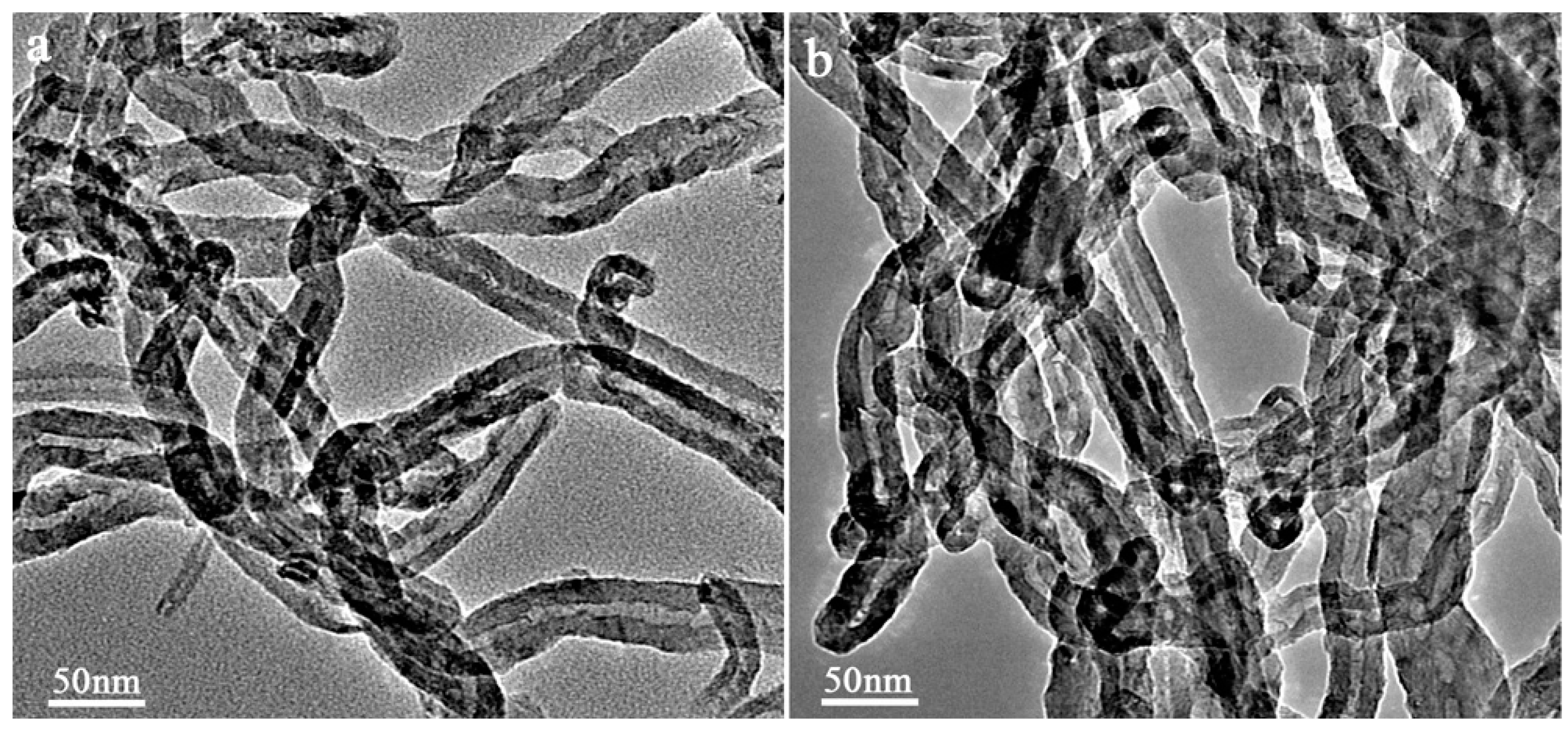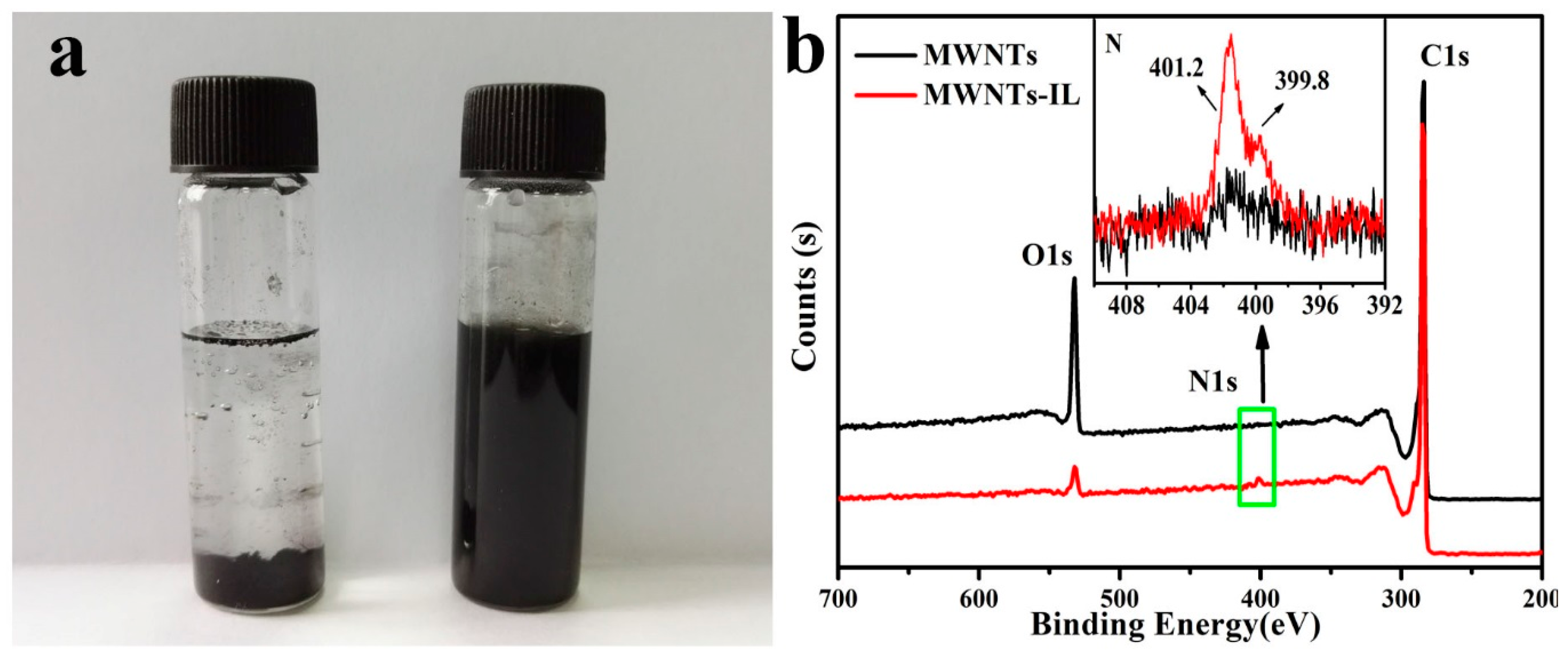Imidazolium Ionic Liquid Functionalized Carbon Nanotubes for Improved Interfacial Charge Transfer and Simultaneous Determination of Dihydroxybenzene Isomers
Abstract
:1. Introduction
2. Results and Discussion
2.1. Structural Properties of MWNTs and MWNTs-IL Composite
2.2. Electrochemical Characterization of MWNT-ILs Modified Electrode
2.3. Redox Behavior of Dihydroxybenzene Isomers on MWNTs-IL/GCE
2.4. Determination of Dihydroxybenzene Isomers at MWNTs-IL/GCE
2.4.1. Individual Determination of HQ, CC or RC in Their Mixtures
2.4.2. Simultaneous Determination of Dihydroxybenzene Isomers at MWNTs-IL/GCE
2.4.3. Application to the Yellow River Samples
3. Discussion
4. Experimental Section
4.1. Reagents
4.2. Preparation of MWNTs-IL
4.3. Electrode Preparation
4.4. Instruments
5. Conclusions
Supplementary Materials
Acknowledgments
Author Contributions
Conflicts of Interest
References
- Safavi, A.; Maleki, N.; Moradlou, O.; Sorouri, M. Direct electrochemistry of hemoglobin and its electrocatalytic effect based on its direct immobilization on carbon ionic liquid electrode. Electrochem. Commun. 2008, 10, 420–423. [Google Scholar] [CrossRef]
- Pramparo, L.; Suárez-Ojeda, M.E.; Pérez, J.; Carrera, J. Kinetics of aerobic biodegradation of dihydroxybenzenes by a p-nitrophenol-degrading activated sludge. Bioresour. Technol. 2012, 110, 57–62. [Google Scholar] [CrossRef] [PubMed]
- Nagaraja, P.; Vasantha, R.; Sunitha, K. A sensitive and selective spectrophotometric estimation of catechol derivatives in pharmaceutical preparations. Talanta 2001, 55, 1039–1046. [Google Scholar] [CrossRef]
- Yao, L.-F.; He, H.-B.; Feng, Y.-Q.; Da, S.-L. HPLC separation of positional isomers on a dodecylamine-N, N-dimethylenephosphonic acid modified zirconia stationary phase. Talanta 2004, 64, 244–251. [Google Scholar] [CrossRef] [PubMed]
- Yang, J.; Zhang, S.; Liu, S. Simultaneous determination of three dihydroxybenzene isomers by synchronous-polarization-derivative fluorescence spectrometry. Acta Chim. Sin. Chin. Ed. 2007, 65. [Google Scholar] [CrossRef]
- Wang, Z.; Sun, Z.; Zhu, H.; Gao, G.; Liu, H.; Zhao, X. Simultaneous determination of dihydroxybenzene isomers using preanodized inlaying ultrathin carbon paste electrode. Electroanalysis 2010, 22, 1737–1742. [Google Scholar] [CrossRef]
- Zhu, S.; Gao, W.; Zhang, L.; Zhao, J.; Xu, G. Simultaneous voltammetric determination of dihydroxybenzene isomers at single-walled carbon nanohorn modified glassy carbon electrode. Sens. Actuators B Chem. 2014, 198, 388–394. [Google Scholar] [CrossRef]
- Wei, C.; Huang, Q.; Hu, S.; Zhang, H.; Zhang, W.; Wang, Z.; Zhu, M.; Dai, P.; Huang, L. Simultaneous electrochemical determination of hydroquinone, catechol and resorcinol at Nafion/multi-walled carbon nanotubes/carbon dots/multi-walled carbon nanotubes modified glassy carbon electrode. Electrochim. Acta 2014, 149, 237–244. [Google Scholar] [CrossRef]
- Zhu, G.; Yi, Y.; Sun, H.; Wang, K.; Han, Z.; Wu, X. Cyclodextrin-functionalized hollow carbon nanospheres by introducing nanogold for enhanced electrochemical sensing of o-dihydroxybenzene and p-dihydroxybenzene. J. Mater. Chem. B 2015, 3, 45–52. [Google Scholar] [CrossRef]
- Park, M.J.; Lee, J.K.; Lee, B.S.; Lee, Y.-W.; Choi, I.S.; Lee, S.-G. Covalent modification of multiwalled carbon nanotubes with imidazolium-based ionic liquids: Effect of anions on solubility. Chem. Mater. 2006, 18, 1546–1551. [Google Scholar] [CrossRef]
- Wang, Z.; Zhang, Q.; Kuehner, D.; Xu, X.; Ivaska, A.; Niu, L. The synthesis of ionic-liquid-functionalized multiwalled carbon nanotubes decorated with highly dispersed Au nanoparticles and their use in oxygen reduction by electrocatalysis. Carbon 2008, 46, 1687–1692. [Google Scholar] [CrossRef]
- Wang, Z.; Latonen, R.-M.; Kvarnström, C.; Ivaska, A.; Niu, L. Preparation of multi-walled carbon nanotube/amino-terminated ionic liquid arrays and their electrocatalysis towards oxygen reduction. Materials 2010, 3, 672–681. [Google Scholar] [CrossRef]
- Zhang, X.; Jiao, K.; Wang, X. Paste electrode based on short single-walled carbon nanotubes and room temperature ionic liquid: Preparation, characterization and application in DNA detection. Electroanalysis 2008, 20, 1361–1366. [Google Scholar] [CrossRef]
- Zhao, C.; Wang, Y.; Shi, F.; Zhang, J.; Zhu, J.-J. High biocurrent generation in Shewanella-inoculated microbial fuel cells using ionic liquid functionalized graphene nanosheets as an anode. Chem. Commun. 2013, 49, 6668–6670. [Google Scholar] [CrossRef] [PubMed]
- Karousis, N.; Tagmatarchis, N.; Tasis, D. Current progress on the chemical modification of carbon nanotubes. Chem. Rev. 2010, 110, 5366–5397. [Google Scholar] [CrossRef] [PubMed]
- Freger, V. Diffusion impedance and equivalent circuit of a multilayer film. Electrochem. Commun. 2005, 7, 957–961. [Google Scholar] [CrossRef]
- Cui, Y.-P.; Zhu, Y.; Li, Y.-L.; Wang, W.-X.; Xu, F. Electrochemical behavior of dihydroxybenzene isomers at MWCNTs modified electrode and simultaneous determination in neutral condition. Res. Chem. Intermed. 2014, 40, 3153–3162. [Google Scholar] [CrossRef]
- Liu, Y.; Wang, W.; Wei, H.; Li, J.; Lu, X.; Liu, X. Simultaneous determination of dihydroxybenzene isomers based on thionine functionalized multiwall carbon nanotubes modified electrode. J. Appl. Electrochem. 2014, 44, 667–674. [Google Scholar] [CrossRef]
- Dong, J.; Qu, X.; Wang, L.; Zhao, C.; Xu, J. Electrochemistry of nitrogen-doped carbon nanotubes (CNx) with different nitrogen content and its application in simultaneous determination of dihydroxybenzene isomers. Electroanalysis 2008, 20, 1981–1986. [Google Scholar] [CrossRef]
- Lu, W.; Qu, L.; Henry, K.; Dai, L. High performance electrochemical capacitors from aligned carbon nanotube electrodes and ionic liquid electrolytes. J. Power Sources 2009, 189, 1270–1277. [Google Scholar] [CrossRef]
- Fukushima, T.; Aida, T. Ionic liquids for soft functional materials with carbon nanotubes. Chem. A Eur. J. 2007, 13, 5048–5058. [Google Scholar] [CrossRef] [PubMed]
- Zhang, Y.; Shen, Y.; Yuan, J.; Han, D.; Wang, Z.; Zhang, Q.; Niu, L. Design and synthesis of multifunctional materials based on an ionic-liquid backbone. Angew. Chem. Int. Ed. 2006, 45, 5867–5870. [Google Scholar] [CrossRef] [PubMed]
- Sample Availability: Not Available.







| Isomer | Linear Regression Equation | R | Peak/mV | Linear Range/mol·L−1 | Detection Limit/mol·L−1 |
|---|---|---|---|---|---|
| CC | ip = −0.071–0.046c | 0.999 | 180 | 9.0 × 10−7–1.5 × 10−4 | 1.0 × 10−7 |
| RC | ip = 0.060–0.021c | 0.998 | 547 | 1.9 × 10−6–1.45 × 10−4 | 3.8 × 10−7 |
| HQ | ip = 0.118–0.035c | 0.999 | 78 | 9.0 × 10−7–1.5 × 10−4 | 1.5 × 10−7 |
| Electrode | Linear Range (μM) | Limit of Detection (μM) | Ref. | ||||
|---|---|---|---|---|---|---|---|
| HQ | CC | RC | HQ | CC | RC | ||
| SWCNH/GCE | 0.5–100 | 0.5–100 | 1.0–100 | 0.10 | 0.20 | 0.50 | [7] |
| MWNTs/CDs/MWNTs/GCE | 1.0–200 | 4.0–200 | 1.0–400 | 0.60 | 0.60 | 1.00 | [8] |
| MWCNTs/GCE | 20–140 | 20–140 | 20–140 | 1.00 | 1.30 | 4.70 | [17] |
| TH-MWNTs/GCE | 0.9–360 | 3.3–810 | 4.3–900 | 0.27 | 1.00 | 1.10 | [18] |
| CNx/GCE | 10–1000 | 20–1000 | 50–1000 | 1.20 | 2.71 | 5.64 | [19] |
| MWNTs-IL/GCE | 0.9–150 | 0.9–150 | 1.9–145 | 0.15 | 0.10 | 0.38 | This paper |
| Isomer | Added (μM) | Found (μM) | Recovery (%) |
|---|---|---|---|
| CC | 20.00 | 19.02 | 95.1 |
| 25.00 | 24.62 | 98.5 | |
| RC | 20.00 | 21.73 | 108.7 |
| 25.00 | 25.96 | 103.8 | |
| HQ | 20.00 | 21.09 | 105.4 |
| 25.00 | 26.51 | 106.0 |
© 2016 by the authors. Licensee MDPI, Basel, Switzerland. This article is an open access article distributed under the terms and conditions of the Creative Commons Attribution (CC-BY) license ( http://creativecommons.org/licenses/by/4.0/).
Share and Cite
Wei, H.; Wu, X.-S.; Wen, G.-Y.; Qiao, Y. Imidazolium Ionic Liquid Functionalized Carbon Nanotubes for Improved Interfacial Charge Transfer and Simultaneous Determination of Dihydroxybenzene Isomers. Molecules 2016, 21, 617. https://doi.org/10.3390/molecules21050617
Wei H, Wu X-S, Wen G-Y, Qiao Y. Imidazolium Ionic Liquid Functionalized Carbon Nanotubes for Improved Interfacial Charge Transfer and Simultaneous Determination of Dihydroxybenzene Isomers. Molecules. 2016; 21(5):617. https://doi.org/10.3390/molecules21050617
Chicago/Turabian StyleWei, Huan, Xiao-Shuai Wu, Guo-Yun Wen, and Yan Qiao. 2016. "Imidazolium Ionic Liquid Functionalized Carbon Nanotubes for Improved Interfacial Charge Transfer and Simultaneous Determination of Dihydroxybenzene Isomers" Molecules 21, no. 5: 617. https://doi.org/10.3390/molecules21050617
APA StyleWei, H., Wu, X.-S., Wen, G.-Y., & Qiao, Y. (2016). Imidazolium Ionic Liquid Functionalized Carbon Nanotubes for Improved Interfacial Charge Transfer and Simultaneous Determination of Dihydroxybenzene Isomers. Molecules, 21(5), 617. https://doi.org/10.3390/molecules21050617






